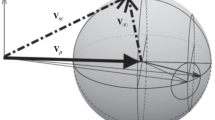Abstract
A modification to the vis-viva equation that accounts for general relativistic effects is introduced to enhance the accuracy of predictions of orbital motion and precession. The updated equation reduces to the traditional vis-viva equation under Newtonian conditions and is a more accurate tool for astrodynamics than the traditional equation. Preliminary simulation results demonstrate the application potential of the modified vis-viva equation for more complex n-body systems. Spherical symmetry is assumed in this approach; however, this limitation could be removed in future research. This study is a pivotal step toward bridging classical and relativistic mechanics and thus makes an important contribution to the field of celestial dynamics.
Graphical abstract


Similar content being viewed by others
References
Smith, G.E.: The vis viva dispute: a controversy at the dawn of dynamics. Phys. Today 59(10), 31–36 (2006)
Terrall, M.: Vis viva revisited. Hist. Sci. 42, 189–209 (2004)
Iltis, C.: Leibniz and the Vis Viva Controversy. University of Chicago Express, New York (2010)
Greenberg, J.L.: Mathematical physics in eighteenth-century france. Isis 77(1) (1986)
Logsdon, T.: Orbital Mechanics: Theory and Applications. Wiley, Hoboken (1998)
McDonough, J.K.: Leibniz’s philosophy of physics. In: The Stanford Encyclopedia of Philosophy. Fall 2021 ed., Metaphysics Research Lab, Stanford University (2021)
Schutz, B.: A First Course in General Relativity. Cambridge University Press, Cambridge (2009)
Li, L.-f., Cao, Z.: Post-keplerian waveform model for binary compact object as sources of space-based gravitational wave detector and its implications. Gen. Relativ. Gravit. (2023)
Astesiano, D., Ruggiero, M.: Can general relativity play a role in galactic dynamics? Phys. Rev. D 106, 121501 (2022)
Ryabushko, A., Zhur, T.: Dark matter and motion of bodies in space 58, 318–326 (2022)
Acknowledgements
SY is supported in part by the JSPS KAKENHI Grant Number JP20K03968 and JP 23H00108. KI is supported by the JSPS Grant Number 21H04467, JST FOREST Program JPMJFR20352935, and by JSPS Core-to-Core Program (Grant Number: JPJSCCA20200002, JPJSCCA20200003).
Author information
Authors and Affiliations
Corresponding author
Additional information
Publisher's Note
Springer Nature remains neutral with regard to jurisdictional claims in published maps and institutional affiliations.
Rights and permissions
Springer Nature or its licensor (e.g. a society or other partner) holds exclusive rights to this article under a publishing agreement with the author(s) or other rightsholder(s); author self-archiving of the accepted manuscript version of this article is solely governed by the terms of such publishing agreement and applicable law.
About this article
Cite this article
Peng, Q., Yokoyama, S. & Ichiki, K. General relativistic approach to the vis-viva equation on Schwarzschild metric. Gen Relativ Gravit 56, 48 (2024). https://doi.org/10.1007/s10714-024-03235-7
Received:
Accepted:
Published:
DOI: https://doi.org/10.1007/s10714-024-03235-7




